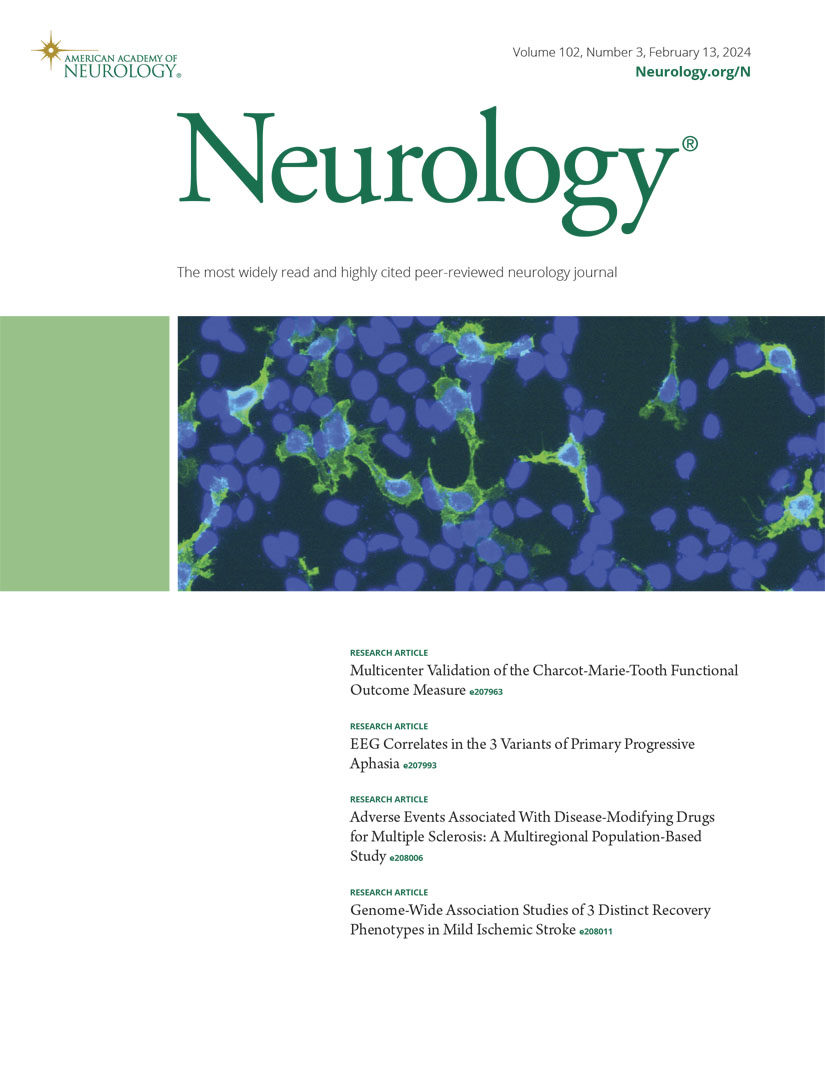非局灶性短暂性神经发作的发生率和决定因素:鹿特丹研究。
IF 7.7
1区 医学
Q1 CLINICAL NEUROLOGY
引用次数: 0
摘要
背景和目的最近的文献表明,非局灶性短暂性神经系统发作(tna)患者的心血管疾病风险未升高,但这些发作的起源尚不清楚。因此,我们在一项前瞻性队列研究中调查了它们的发病率和潜在危险因素,并假设它们与心血管危险因素的关联。方法:在荷兰以人群为基础的鹿特丹研究中,在1990年、2000年和2006年开始的研究队列中,对45岁或以上的社区生活个体进行了人口统计学和心血管危险因素的评估。随后,通过自动链接研究数据库与参与者全科医生的医疗记录,对参与者进行随访,直到2021年1月1日。在本研究中,选择基线时无TNA的参与者,并对非局灶性TNA的结果进行随访。通过年龄特异性发病率(IRs)确定非局灶性TNA的风险。非局灶性TNA的潜在危险因素采用病因特异性、多变量、Cox比例风险模型,考虑年龄、性别、教育程度(大学或高等职业教育vs低教育水平)、心血管危险因素、颈动脉粥样硬化超声标志物、抗血栓药物使用和血管疾病史。敏感性分析包括在研究开始时没有任何血管疾病史的参与者中进行这种回归。结果14096名参与者(平均[SD]年龄65.5[10.3]岁,59.0%为女性)的204474人年随访后,发生518例指数非局灶性tna(3.7%)。非局灶性TNA的发病率随着年龄的增长而增加,55 - 59岁人群的IR为每10万人-年随访65.5 (95% CI 33.6-116.2), 85岁及以上人群的IR为每10万人-年随访424.0 (95% CI 348.0-512.0)。年龄较大(风险比[HR] 1.08, 95% CI 1.07-1.09)、受教育程度较低(HR 1.62, 95% CI 1.15-2.29)、颈动脉超声上出现斑块(HR 0.80, 95% CI 0.65-1.00)和使用抗血栓药物(HR 0.59, 95% CI 0.39-0.90)均与非局灶性TNA的风险独立相关。在对12,499名没有血管病史的个体进行限制分析后,只有年龄和最高受教育程度与非局灶性TNA风险的关联仍然具有统计学意义。非局灶性TNAs主要影响老年人和受教育程度较低的人,这表明这些发作源于社会经济决定因素,而不是既定的心血管危险因素。本文章由计算机程序翻译,如有差异,请以英文原文为准。
Incidence and Determinants of Nonfocal Transient Neurologic Attacks: The Rotterdam Study.
BACKGROUND AND OBJECTIVES
Recent literature suggests no elevated risk of cardiovascular disease in patients having nonfocal transient neurologic attacks (TNAs), yet the origin of these attacks remains unclear. Therefore, we investigated their incidence and potential risk factors in a prospective cohort study, hypothesizing associations with cardiovascular risk factors.
METHODS
Within the Dutch population-based Rotterdam Study, community-living individuals aged 45 years or older underwent assessment for demographic and cardiovascular risk factors in study cohorts initiated in 1990, 2000, and 2006. Participants were subsequently followed until January 1, 2021, for disease incidence through automated linkage of the study database with medical records from participants' general practitioners. For this study, participants free from TNA at baseline were selected and followed up for the outcome of a nonfocal TNA. The risk of nonfocal TNA was determined through age-specific incidence rates (IRs). Potential risk factors of nonfocal TNA were identified using cause-specific, multivariable, Cox proportional hazard modeling accounting for age, sex, education (university or higher vocational vs lower education level), cardiovascular risk factors, ultrasound markers of carotid atherosclerosis, antithrombotic medication use, and a history of vascular diseases. Sensitivity analyses consisted of conducting this regression among participants without any history of vascular disease at study entrance.
RESULTS
After 204,474 person-years of follow-up in 14,096 participants (mean [SD] age 65.5 [10.3] years, 59.0% female), 518 index nonfocal TNAs (3.7%) occurred. The incidence of nonfocal TNA increased with age, with an IR in those aged between 55 and 59 years of 65.5 (95% CI 33.6-116.2) per 100,000 person-years of follow-up to 424.0 (95% CI 348.0-512.0) in those aged 85 years or older. Older age (hazard ratio [HR] 1.08, 95% CI 1.07-1.09), a lower education level (HR 1.62, 95% CI 1.15-2.29), plaque presence on carotid ultrasound (HR 0.80, 95% CI 0.65-1.00), and the use of antithrombotics (HR 0.59, 95% CI 0.39-0.90) were all independently associated with the risk of nonfocal TNA. After restricting analyses to the 12,499 individuals without history of vascular disease, only the associations of age and a higher maximum attained education level with the risk of nonfocal TNA remained statistically significant.
DISCUSSION
Nonfocal TNAs predominantly affect older adults and those with lower educational attainment, suggesting that these attacks originate from socioeconomic determinants rather than from established cardiovascular risk factors.
求助全文
通过发布文献求助,成功后即可免费获取论文全文。
去求助
来源期刊

Neurology
医学-临床神经学
CiteScore
12.20
自引率
4.00%
发文量
1973
审稿时长
2-3 weeks
期刊介绍:
Neurology, the official journal of the American Academy of Neurology, aspires to be the premier peer-reviewed journal for clinical neurology research. Its mission is to publish exceptional peer-reviewed original research articles, editorials, and reviews to improve patient care, education, clinical research, and professionalism in neurology.
As the leading clinical neurology journal worldwide, Neurology targets physicians specializing in nervous system diseases and conditions. It aims to advance the field by presenting new basic and clinical research that influences neurological practice. The journal is a leading source of cutting-edge, peer-reviewed information for the neurology community worldwide. Editorial content includes Research, Clinical/Scientific Notes, Views, Historical Neurology, NeuroImages, Humanities, Letters, and position papers from the American Academy of Neurology. The online version is considered the definitive version, encompassing all available content.
Neurology is indexed in prestigious databases such as MEDLINE/PubMed, Embase, Scopus, Biological Abstracts®, PsycINFO®, Current Contents®, Web of Science®, CrossRef, and Google Scholar.
 求助内容:
求助内容: 应助结果提醒方式:
应助结果提醒方式:


